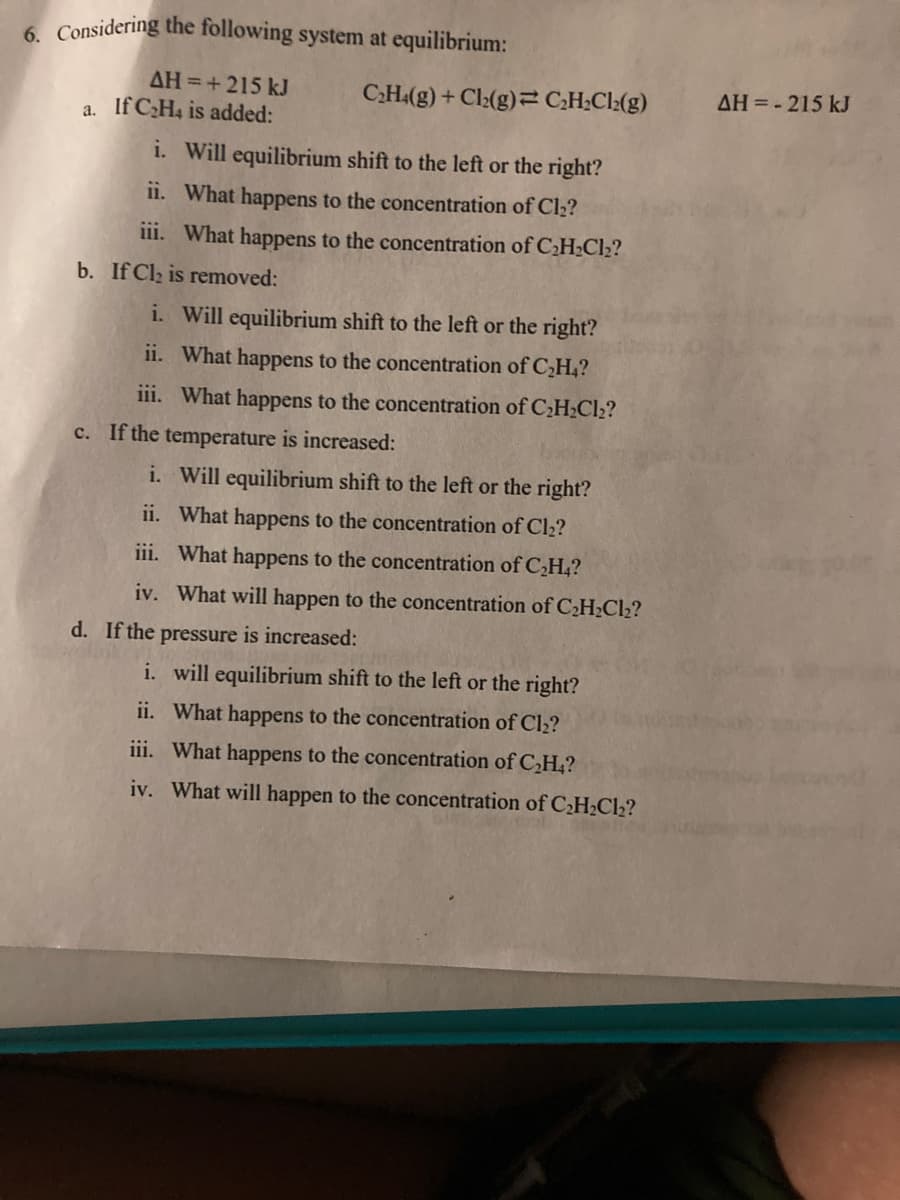Considering the following system at equilibrium: AH =+ 215 kJ AH = - 215 kJ %3D CH(g) + Cl:(g)2 C,H;Cl;(g) a. If C;H4 is added: i. Will equilibrium shift to the left or the right? ii. What happens to the concentration of Cl2? iii. What happens to the concentration of C2H½CI2? b. If Cl2 is removed: i. Will equilibrium shift to the left or the right? ii. What happens to the concentration of C,H,? iii. What happens to the concentration of C2H2CI2? c. If the temperature is increased: i. Will equilibrium shift to the left or the right? ii. What happens to the concentration of Cl2? iii. What happens to the concentration of C,H,? iv. What will happen to the concentration of CH;Cl2?
Considering the following system at equilibrium: AH =+ 215 kJ AH = - 215 kJ %3D CH(g) + Cl:(g)2 C,H;Cl;(g) a. If C;H4 is added: i. Will equilibrium shift to the left or the right? ii. What happens to the concentration of Cl2? iii. What happens to the concentration of C2H½CI2? b. If Cl2 is removed: i. Will equilibrium shift to the left or the right? ii. What happens to the concentration of C,H,? iii. What happens to the concentration of C2H2CI2? c. If the temperature is increased: i. Will equilibrium shift to the left or the right? ii. What happens to the concentration of Cl2? iii. What happens to the concentration of C,H,? iv. What will happen to the concentration of CH;Cl2?
Chemistry: An Atoms First Approach
2nd Edition
ISBN:9781305079243
Author:Steven S. Zumdahl, Susan A. Zumdahl
Publisher:Steven S. Zumdahl, Susan A. Zumdahl
Chapter12: Chemical Equilibrium
Section: Chapter Questions
Problem 1ALQ: Consider an equilibrium mixture of four chemicals (A, B, C, and D, all gases) reacting in a closed...
Related questions
Question

Transcribed Image Text:6. Considering the following system at equilibrium:
AH =+ 215 kJ
C.H.(g) + Cl:(g)= C;H;Cl:(g)
AH = - 215 kJ
a. If CH4 is added:
i. Will equilibrium shift to the left or the right?
ii. What happens to the concentration of Cl2?
iii. What happens to the concentration of C2H;Cl2?
b. If Cl2 is removed:
i. Will equilibrium shift to the left or the right?
ii. What happens to the concentration of C,H,?
iii. What happens to the concentration of CH;Cl2?
c. If the temperature is increased:
i. Will equilibrium shift to the left or the right?
ii. What happens to the concentration of Cl2?
iii. What happens to the concentration of C,H,?
iv. What will happen to the concentration of C¿H¿Cl2?
d. If the pressure is increased:
i. will equilibrium shift to the left or the right?
ii. What happens to the concentration of Cl2?
iii. What happens to the concentration of C,H,?
iv. What will happen to the concentration of CH2C12?
Expert Solution
This question has been solved!
Explore an expertly crafted, step-by-step solution for a thorough understanding of key concepts.
Step by step
Solved in 4 steps

Knowledge Booster
Learn more about
Need a deep-dive on the concept behind this application? Look no further. Learn more about this topic, chemistry and related others by exploring similar questions and additional content below.Recommended textbooks for you

Chemistry: An Atoms First Approach
Chemistry
ISBN:
9781305079243
Author:
Steven S. Zumdahl, Susan A. Zumdahl
Publisher:
Cengage Learning

Chemistry
Chemistry
ISBN:
9781305957404
Author:
Steven S. Zumdahl, Susan A. Zumdahl, Donald J. DeCoste
Publisher:
Cengage Learning


Chemistry: An Atoms First Approach
Chemistry
ISBN:
9781305079243
Author:
Steven S. Zumdahl, Susan A. Zumdahl
Publisher:
Cengage Learning

Chemistry
Chemistry
ISBN:
9781305957404
Author:
Steven S. Zumdahl, Susan A. Zumdahl, Donald J. DeCoste
Publisher:
Cengage Learning


Chemistry for Engineering Students
Chemistry
ISBN:
9781337398909
Author:
Lawrence S. Brown, Tom Holme
Publisher:
Cengage Learning

Chemistry & Chemical Reactivity
Chemistry
ISBN:
9781133949640
Author:
John C. Kotz, Paul M. Treichel, John Townsend, David Treichel
Publisher:
Cengage Learning

Chemistry & Chemical Reactivity
Chemistry
ISBN:
9781337399074
Author:
John C. Kotz, Paul M. Treichel, John Townsend, David Treichel
Publisher:
Cengage Learning